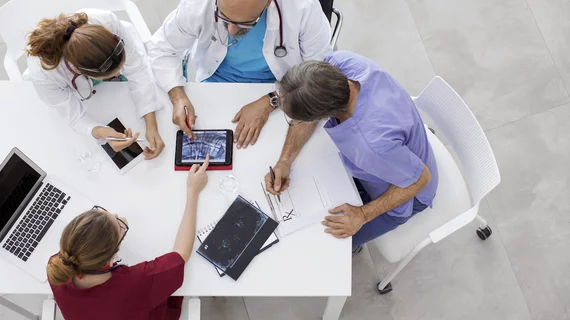5 factors in becoming a more persuasive radiologist
Harnessing the power of persuasion is useful for sharing new ideas, solving problems and becoming an effective leader. Understanding central concepts of the trait can also help one become a better radiologist
Nupur Verma, MD, with the radiology department at the University of Florida in Gainesville, and two colleagues explored how a radiologist can become more persuasive in an Aug. 23 commentary published August 23 in the Journal of the American College of Radiology.
Studies have found there are two characteristics present in those with a proclivity for persuasion—affinity and authority. Although these traits may be difficult to master, small shifts in behavior can help instill them in a radiologist to become more persuasive.
For example, Verma et al. suggested turning off device notifications, maintaining eye contact and practicing general listening when meeting with a colleague to demonstrate warmth and authenticity.
“Over time, building positive interactions and showing genuine presence can increase your charisma and improve your persuasiveness,” the group suggested.
Authority, however, may take longer to demonstrate. The unique training and experience that shows you have the knowledge to back-up what you are communicating can go a long way. Just be careful not to come across as condescending, Verma et al. warned.
In addition to these traits, the authors cited three important elements of persuasion that can be practiced and implemented:
Emotional connection
This boils down to establishing a bond between “you, your request, and the audience,” Verma et al. wrote. In radiology, it can be as simple as the shared goal of putting the patient first.
“Making this connection allows you, the persuasive radiologist, to present the request as a win-win situation for all parties,” they added.
Evidence
Without putting forth adequate evidence, a request is likely to fall flat and your persuasiveness will as well, Verma and colleagues wrote.
Those who present well organized and transparent evidence in an honest fashion will retain their credibility and can establish a persuasive nature.
“For example, when proposing a new initiative to collect patient surveys and use the feedback to improve customer service, you can provide information on how this has been implemented at other institutions and present data on its effectiveness,” they suggested.
Reciprocity
Requests are not a one-sided interaction. A radiologist should see that returning the favor can not only motivate a group, but help them agree to a request and abide by its change, the authors wrote.
“Reciprocity can be unreliable if a single member of the group does not participate; however, failing to participate in reciprocity is most often the exception rather than the rule,” they concluded.

